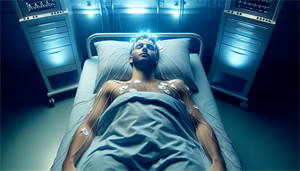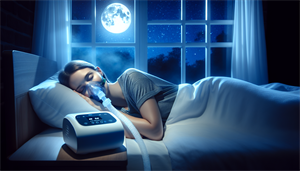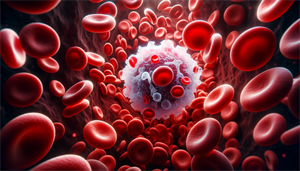Imagine being trapped in a vicious cycle of disrupted sleep, where the struggle to breathe wakes you up and the inability to stay asleep makes it harder to breathe. This scenario is all too familiar for those grappling with comorbid sleep apnea and insomnia.
In the labyrinth of sleep disorders, these two conditions often cross paths, complicating symptoms and solutions. But what if we told you that understanding the interaction between sleep apnea and insomnia is a game-changer?
This blog post aims to illuminate the intricate relationship between these two sleep disorders, guide you through their diagnosis, and explore effective sleep apnea and insomnia treatment strategies. Let’s embark on this journey to reclaim restful nights.
Key Takeaways
-
COMISA (Comorbid Insomnia and Sleep Apnea) is common and complex, requiring a simultaneous treatment approach and a comprehensive diagnostic process due to overlapping symptoms that can exacerbate each other.
-
Diagnosis of sleep disorders demands expertise from sleep specialists and involves a combination of clinical interviews, sleep studies, and the use of diagnostic tools like polysomnography and actigraphy.
-
Effective treatment for sleep disorders like sleep apnea and insomnia may involve a combination of CPAP therapy and cognitive behavioral therapy (CBT-I), along with lifestyle adjustments such as improving diet, exercise, and sleep environment.
Unveiling the Link Between Sleep Apnea and Insomnia

Understanding sleep apnea and insomnia as separate entities is straightforward, but when they intertwine, the picture becomes more complex. The coexistence of these two conditions, also known as COMISA (Comorbid Insomnia and Sleep Apnea), is more common than one might think. The overlapping symptoms and their propensity to exacerbate each other can lead to a challenging diagnostic process.
It might surprise you to learn how common chronic insomnia symptoms are in individuals diagnosed with Obstructive Sleep Apnea (OSA). The complexity of the relationship between sleep apnea and insomnia is such that it demands a simultaneous treatment approach to provide the most beneficial outcomes. To understand the complex interaction between these conditions, we will further discuss the various aspects of comorbid sleep disorders, including insomnia and osa.
Understanding Comorbid Sleep Disorders
Comorbid Insomnia and Sleep Apnea (COMISA) manifests as the simultaneous presence of sleep maintenance insomnia and sleep apnea in an individual. The diagnosis process for COMISA is multi-faceted, incorporating:
-
Clinical interviews
-
Sleep diaries
-
Actigraphy
-
Self-report questionnaires, including the Insomnia Severity Index
Patient demographics significantly influence the prevalence of COMISA. Here are some key factors to consider:
-
More women exhibit symptoms of insomnia
-
More men report experiencing witnessed apneas
-
Older age serves as a risk factor, increasing the likelihood of COMISA
Diagnosing this condition is no simple task, with over 50% of sleep related breathing disorder patients, also known as Sleep-Disordered Breathing (SDB), reporting significant poor sleep complaints. The overlapping symptoms pose a challenge for clinicians, necessitating a comprehensive approach to diagnosis.
The Impact of Sleep Apnea on Insomnia Symptoms

Sleep apnea not only disrupts breathing during sleep but also exacerbates insomnia symptoms. Factors such as nocturia (excessive urination at night), arousals, and anxiety can significantly impact sleep quality. Interestingly, the use of Continuous Positive Airway Pressure (CPAP) therapy, a common treatment for sleep apnea, may perpetuate the symptoms of insomnia due to increased awakenings during therapy.
Moreover, factors like mask discomfort due to frequent awakenings and conditions like anxiety and depression contribute to low CPAP therapy adherence in OSA and insomnia patients. These aspects highlight the complex interplay of sleep apnea and insomnia symptoms, emphasizing the need for a comprehensive understanding of these conditions.
How Insomnia Exacerbates Sleep Apnea
While sleep apnea can worsen insomnia, the reverse is also true. Insomnia can contribute to sleep apnea symptoms by:
-
reducing the threshold for respiratory arousal
-
increasing the likelihood of sleep-disordered breathing
-
resulting in breathing instability in OSA patients
-
exacerbating the severity of sleep apnea.
Hypnotics, a type of sleep medication, show promise in reducing sleep apnea severity in patient subgroups with low respiratory arousal thresholds. Furthermore, nonbenzodiazepine agents can enhance the tolerance of CPAP therapy for OSA patients, addressing both sleep apnea and insomnia simultaneously. This complex interaction between insomnia and sleep apnea calls for a thorough diagnostic process to untangle the entwined symptoms.
Diagnosing the Dual Dilemma: Identifying Sleep Apnea and Insomnia
Navigating the maze of sleep apnea and insomnia requires strategic diagnostic procedures. The diagnostic journey involves specialists who possess the expertise to diagnose and address various sleep disorders like sleep apnea and insomnia.
Sleep apnea is usually diagnosed through nocturnal polysomnography, a sleep study that involves monitoring sleep patterns and analyzing the recordings by a qualified sleep specialist. On the other hand, insomnia is diagnosed based on the consistency of difficulty falling or staying asleep for a minimum of three nights per week.
Discerning between sleep apnea and insomnia, and comprehending their coexistence, necessitates thorough specialist consultations and sleep studies. We will now delve into these aspects in greater detail.
The Role of a Sleep Specialist
A sleep specialist serves as the captain of the ship in the sea of sleep disorders. These specialists undergo a one-year sleep medicine fellowship program to acquire clinical training and research exposure in sleep medicine. Their responsibilities encompass patient screening, ordering and interpreting diagnostic tests, and delivering conclusive diagnoses for conditions like sleep apnea and insomnia.
Sleep specialists:
-
Employ distinct assessment tools
-
Utilize evidence-based treatments
-
Follow referral pathways to evaluate comorbid sleep disorders
-
Conduct sleep studies to monitor a patient’s brain activity during sleep
This enables them to provide personalized care and manage the complexities of conditions like sleep apnea and insomnia.
Utilizing Sleep Studies

Sleep studies are the compass guiding the way to accurate diagnoses of sleep disorders. These comprehensive overnight tests monitor breathing, brain activity, and muscle activity to detect any abnormalities that may be causing sleep disturbances, disrupting sleep patterns.
Polysomnography, a comprehensive sleep study, is the gold standard for diagnosing sleep apnea. It monitors various body functions during sleep and can also include split-night studies for a combined diagnosis and CPAP titration.
Actigraphy, another diagnostic tool, quantifies movement and activity levels through a compact wrist-worn device. It provides detailed graphical representations of sleep parameters and patterns, playing a crucial role in diagnosing and assessing sleep disorders like sleep apnea and insomnia.
Now that we comprehend the diagnostic process, we can proceed to discuss the treatment options.
A Two-Pronged Approach to Treatment

When it comes to treating sleep apnea and insomnia, a combined approach is often more beneficial. Studies have shown that a four-session Cognitive Behavioral Therapy for Insomnia (CBT-I) administered by a Behavioral Sleep Medicine (BSM) provider, in conjunction with Positive Airway Pressure (PAP) therapy, has yielded significant improvements in comorbid sleep disorders.
CPAP therapy, used to manage sleep apnea, can also help improve insomnia symptoms if the latter is caused by sleep apnea. However, selecting the most suitable approach, whether it involves initiating PAP therapy, implementing CBT for insomnia, or a combination of both, requires clinical judgement and is particularly important due to the current lack of comprehensive data on the concurrent treatment of these conditions.
We will now examine the two key components of this treatment approach in detail: Positive Airway Pressure Therapy and Cognitive Behavioral Therapy for Insomnia.
Positive Airway Pressure Therapy
Continuous Positive Airway Pressure (CPAP) therapy is the reigning champion in the battle against sleep apnea. It is the most widely used treatment for this sleep disorder.
The therapy works by delivering pressurized air through a mask, creating positive pressure in the airway that prevents its collapse during sleep. However, sleep apnea is just one piece of the puzzle.
Cognitive Behavioral Therapy for Insomnia
Cognitive Behavioral Therapy for Insomnia (CBT-I) is a specialized form of therapy designed to address chronic insomnia disorder. Research shows that CBT-I can significantly alleviate insomnia symptoms in individuals with both primary and comorbid insomnia.
CBT for insomnia has also been shown to enhance CPAP adherence, indicating that it is an effective complementary approach in simultaneously addressing sleep apnea and insomnia. Moreover, the flexibility of CBT-I means it can be administered remotely through telehealth models, broadening the reach of treatment and enabling patients to access therapy without physically visiting a healthcare provider.
Lifestyle Adjustments for Better Sleep

While medical treatments play a significant role in managing sleep apnea and insomnia, lifestyle adjustments also hold considerable sway over sleep quality. A healthy diet, regular exercise, and an optimized sleep environment can contribute to improved sleep for those dealing with these sleep disorders.
In the following discussion, we will explore how adjustments in diet and exercise can enhance sleep quality, and how modifying your sleep environment and routine can significantly improve your sleep.
Diet and Exercise Considerations
Diet and exercise are two crucial pillars of health that significantly impact sleep quality. A well-rounded diet, rich in carbohydrates and incorporating tryptophan, melatonin, and phytonutrient-rich foods like cherries, can enhance the quality of sleep for individuals with sleep apnea and insomnia.
Moreover, it is advised to discontinue caffeine consumption 6 to 8 hours prior to bedtime to mitigate sleep disruption. As for exercise, regular aerobic activities like swimming, biking, jogging, or walking, along with yoga, can enhance sleep quality.
Environmental and Routine Changes
Creating a conducive environment for sleep is just as important as having a proper diet and exercise routine. A consistent sleep routine plays a crucial role in training the brain to naturally feel tired at bedtime and can effectively decrease the frequency and severity of sleep apnea events.
Moreover, engaging in activities that could elevate heart rate, such as exercising close to bedtime, or using electronic devices, can prolong the time it takes to fall asleep and hinder relaxation, leading to difficulty falling asleep. Instead, pre-sleep relaxation techniques such as:
-
listening to calming music
-
progressive muscle relaxation
-
meditation
-
self-hypnosis
-
breathing exercises
can relax the mind and body before sleep.
Advanced Therapies and Emerging Research
The landscape of sleep disorder treatment is ever-evolving, with advanced therapies and emerging research continuously adding new dimensions to our understanding of sleep apnea and insomnia. Current investigational treatments under exploration include nonbenzodiazepine GABAergic agents and combinations of cognitive-behavioral therapy for insomnia (CBT-I) with positive airway pressure therapy.
GABAergic nonbenzodiazepine agents can potentially improve sleep quality in patients with OSA, while having little effect on the apnea-hypopnea index. Ongoing studies are also focusing on:
-
data-driven assessment approaches
-
the identification of optimal treatment combinations or sequences beyond CBT-I and PAP
-
the examination of patient-centered factors.
Investigational Treatments
Investigational treatments offer a promising frontier for the management of sleep disorders. Nonbenzodiazepine agents, including eszopiclone, are utilized in the treatment of sleep disorders to enhance the inhibitory impact of GABA.
Currently, treatments such as melatonin agonists like ramelteon, orexin antagonists like suvorexant, and low-dose doxepin are being researched for their potential in reducing insomnia symptoms and enhancing sleep quality.
Additionally, the combination of behavioral approaches with an oral appliance or upper airway stimulation can potentially benefit patients with sleep disorders by enlarging and stabilizing the pharyngeal airway, and improving daytime alertness and productivity.
Ongoing Studies in Sleep Medicine
The world of sleep medicine is a hotbed of research, with ongoing studies shedding light on the intricacies of sleep apnea and insomnia. Current research initiatives are exploring alternative treatment options for sleep apnea, such as oral appliances, upper airway stimulation, and surgical interventions.
Furthermore, there is an increased focus on understanding the causes and complications of sleep apnea, and on exploring new strategies for insomnia. Several promising areas of focus include:
-
The development of new medications
-
Advancements in pharmacological treatments
-
The application of artificial intelligence for personalized therapy
-
The discovery of new targets for treatment
Personalized Care for Sleep Disorders
In the realm of sleep disorders, a one-size-fits-all approach is far from effective. Personalized care tailored to individual patient needs is essential for successful outcomes. A multidisciplinary, patient-centered approach is recommended for optimizing the clinical management of patients with comorbid insomnia and sleep apnea.
Patient education holds significance in elucidating the process and advantages of a multidisciplinary approach, thereby improving comprehension and involvement in the treatment regimen for COMISA patients. In the upcoming discussion, we will delve into the creation of individualized treatment plans and the role of a multidisciplinary approach in enhancing patient outcomes.
Tailoring Treatment to the Patient
The effectiveness of sleep disorder treatments hinges on their customization to individual patient needs. Factors to consider for successful treatment customization include:
-
Pathophysiological risk factors
-
Patient-level knowledge
-
Potential literacy barriers
-
Physical limitations
-
Cognitive, behavioral, structural, and physiological risk factors
By taking these factors into account, treatment can be tailored to meet the specific needs of each patient.
The influence of patient demographics on the approach to treating sleep apnea and insomnia is also significant. Furthermore, patient preference and accessibility to treatment play significant roles in the management of sleep disorders.
Ensuring patients can access treatment is paramount, as it ensures they receive timely and suitable care, including cognitive behavioral therapy, a key component in improving sleep quality and tackling the root causes of these disorders.
Multidisciplinary Management
A multidisciplinary approach to treating sleep disorders encompasses screening, prevention, and intervention for the early identification and comprehensive management of sleep problems. This approach involves a team of healthcare professionals from various disciplines working together to provide personalized care.
Pulmonologists and neurologists play a crucial role in this approach by providing specialized assessment, treatment, and collaboration with other healthcare professionals to optimize patient care. Behavioral specialists and psychologists contribute their expertise in evidence-based psychotherapy to healthcare teams, concentrating on the evaluation and treatment of sleep disorders through cognitive and behavioral interventions.
Navigating Insurance and Access to Care
The journey to manage sleep disorders doesn’t end with diagnosis and treatment options. Understanding health insurance coverage and finding the right resources can play a pivotal role in ensuring that patients can access the care they need.
Typically, health insurance covers treatments for sleep apnea and insomnia, though the degree of coverage might vary based on the specific health plan and the root cause of the insomnia. Most sleep disorder centers accept insurance, and coverage for home sleep tests depends on Medicare, Medicaid, and private insurance, being subject to the insurance company’s policies and medical necessity criteria.
Understanding Health Coverage
Understanding health insurance coverage is integral to navigating the path to treatment for sleep disorders. Health insurance typically includes coverage for the diagnosis and treatment of most sleep disorders, including support for managing sleep apnea and insomnia.
Sleep apnea treatment, like CPAP devices and oral appliances, is typically covered by insurance, with Medicare offering 80% coverage for CPAP devices under Part B, subject to specific conditions being fulfilled. The coverage for insomnia treatment may vary depending on the underlying cause. Nonetheless, the majority of health insurance plans provide coverage for the diagnosis and treatment of different sleep disorders, including insomnia.
Seeking Support and Resources
Beyond insurance coverage, navigating the landscape of sleep disorders also involves seeking appropriate support and resources. Telemedicine offers synchronous encounters for addressing sleep disordered breathing and cognitive behavioral therapy, providing a convenient method for the diagnosis, treatment, and management of sleep apnea and insomnia.
Support groups can also provide a valuable resource for individuals dealing with sleep apnea and insomnia. These groups have demonstrated effectiveness in managing these conditions, resulting in reduced insomnia severity, enhanced treatment satisfaction, and improvements in sleep quality and efficiency.
Individuals facing financial difficulties in managing sleep apnea and insomnia treatments can explore available resources and assistance from reputable organizations like the CDC, Mayo Clinic, and Sleep Foundation.
Summary
Navigating the complexities of sleep apnea and insomnia may seem daunting, but understanding the interplay between these two conditions can be a game-changer. From recognizing the intricate relationship between sleep apnea and insomnia, through the nuances of diagnosis, to exploring a dual approach to treatment, we have shed light on the multifaceted nature of managing these comorbid sleep disorders. Lifestyle adjustments and advanced therapies offer promising avenues to enhance sleep quality. Understanding health coverage and leveraging available resources can help ensure patients’ access to care. Each patient’s journey is unique, and a personalized, multidisciplinary approach is key to optimizing treatment outcomes. The realm of sleep disorders is vast and continually evolving, but with knowledge and resources at our disposal, we can navigate this labyrinth and reclaim restful nights.
Frequently Asked Questions
How long will it take to reverse damage from sleep apnea?
Treating sleep apnea with CPAP for just 12 months can almost entirely reverse damage done to white matter, improving sleep and symptoms while decreasing the risk for cognitive issues.
What is the new treatment for sleep apnea?
The new treatment for sleep apnea is the Inspire® implant, which is the only FDA-approved therapy that works inside the body to treat the root cause of sleep apnea, without the need for a mask or hose.
What happens to your body with untreated sleep apnea?
Untreated sleep apnea can lead to serious health issues, including type 2 diabetes, strokes, heart attacks, and a shortened lifespan. It's crucial to seek treatment for sleep apnea to avoid these risks.
How do you fix sleep apnea without a CPAP machine?
You can fix sleep apnea without a CPAP machine by considering lifestyle adjustments, palate procedures, tongue base reduction, and tonsillectomy or oropharyngeal surgery as alternative options. These can help address contributing factors and provide effective treatment for sleep apnea.
What is COMISA and how prevalent is it?
COMISA is the co-occurrence of sleep maintenance insomnia and sleep apnea. The prevalence of insomnia can vary significantly, ranging from 6% to 48%, based on the conceptualization of insomnia.


